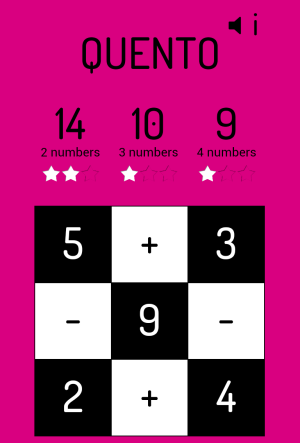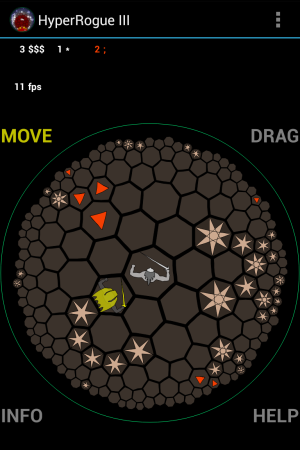I get the Tyne & Wear Metro in and out of work every day. When I don’t have a quality periodical to peruse, I like to play games on my phone. I’ve found a few really good games for my phone that also exercise my maths muscle recently, so I thought I’d write a post about them to share the fun, and prompt you to recommend even more.
Since I’ve got an Android phone, I’m no doubt missing some fantastic games on iOS, but lots of apps these days have versions for both big platforms. I’m also giving UK prices; prices in your country are likely the same numbers with different symbols in front.
Quento
Android, iOS; full version 75p.
You wouldn’t have thought you could get a decent puzzler out of a 3×3 square, but Quento manages it. The interface is very slick as well. The free version is diverting enough, but it’s worth paying 75p for the more complicated challenges.
Simon Tatham’s puzzles
Android, iOS; free
Simon Tatham’s portable puzzle collection is compendious, varied, superb and practically definitive. It contains 36 logic puzzles at the moment, with new additions appearing occasionally, though each puzzle on its own is enough to keep you occupied for years. As well as the puzzles you’d expect (sudoku, minesweeper), there are plenty of ones you won’t have seen before. Personal favourites are Light Up, Slant, Galaxies and, most of all, Loopy – try the Cairo tiling!
The best thing about the collection is the insistence that every puzzle has exactly one solution so you know that you can never fail, you can only be temporarily stuck. Great for working on your logic skills.
HyperRogue III
Android; free
A roguelike on the hyperbolic plane!
That’s all you need to know. The game itself is very simple, but it’s fun to just walk around and repeatedly lose your bearings because distances don’t work the way you think they should.
Huebrix
Android; iOS; full version 63p
I wasn’t sure whether to recommend this. It’s a good challenging puzzle but the popup ads are particularly annoying, and the insulting messages after each puzzle miss the humour mark by quite a distance. Anyway, if you do decide to download it, the idea is to fill the board by dragging paths out from one or more boxes. The paths can’t cross, and and there are a few special kinds of square that constrain your solution. It has a colourblind-friendly mode too, which I’m always in favour of.
The full version adds about 300 levels. I worked through the free set in a couple of commutes.
Flow
Android, iOS; Unlock all levels £2.99
Flow poses basically the same challenge as Huebrix but without the special blocks. I was originally put off by the programmer-art style screenshots, but it’s pleasant enough in action.
Earlier today I asked on Twitter for other people’s recommendations. I got plenty of suggestions for “teach your kids arithmetic” apps or games which happen to involve numbers but otherwise aren’t very mathsy, which is fine and good, but not what I was looking for.
Jim Wilder recommended Tapatan, which is a more complicated elaboration of noughts and crosses for iPhone. Edward Shore recommends Catch-21, also for iPhone, a solitaire blackjack thing based on a US game show. John David Read recommends Blokus, Zentomino, Subway Shuffle and SmartGo. Finally, Katie Steckles recommends Trainyard, a path-drawing game for Android and iOS.
Psst! I can’t recommend the official Set app because it’s rubbish, but this unofficial version made by an unknown person does exactly what you need it to and no more. Don’t tell anyone though, it might get lawyered out of existence.
Do you have a favourite mathsy game you play on the way to work? Post a link in a comment below. Don’t worry about not meeting my exacting standards – I might not be able to bear recommending apps myself, but others are sure to be interested if you’ve found something good.






I like Unblock Me [1], which was recommended to me by a colleague.
Also, there are several nice planar graph drawing puzzles (search for tangle, untangle).
[1] https://play.google.com/store/apps/details?id=com.kiragames.unblockmefree&hl=en
Your list is missing Jeff Weeks’ Torus Games, which offers noughts and crosses, Gomoku, chess, pool and a maze, crossword, word search and jigsaw puzzle on a torus or a Klein bottle. One or two player. iOS only, I think (plus Mac and Windows). It works fine on the phone, though I recall that two player pool on a torus is particularly good on an iPad. The Apple Store page has more screenshots.
Spinpossible and Rogo are both excellent games. The first is written by a mathematician and his son. The game is available on Android, iOS, and on the web for free. I have a couple students working on an undergraduate research project this semester that explores some open problems of Spinpossible. The second game is written by someone in operations research (I think) and is available for iOS (I’m not sure about Android).
Ah yes, spinpossible! I have that paper you posted a while ago saved for a future recreational maths seminar. Rogo sounds familiar but maybe it’s just one of those names.
Try our free iPad game for two-player X-only (ie impartial) Tic-tac-toe, which we’ve christened Notakto. The secret of best play can be found in an 18-element quotient of the free commutative monoid on four letters.
You’ll find a paper “The Secrets of Notakto” in the arXiv.
Thanks for mentioning HyperRogue!
My other game, Hydra Slayer, is based on number theoretic puzzles and therefore should also be recommended for mathematicians… it has an Android version, but it is quite to hard to learn on Android, so probably it is better to try it on a desktop computer first.
Most of my answers were taken, but Solitaire Chess by ThinkFun (iOS and Android) is pretty interesting.
The tournament-style is quite difficult and demands advance participants to spend huge amounts of money.